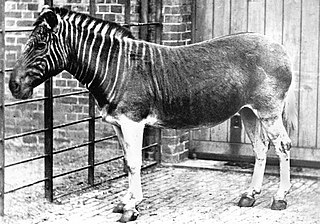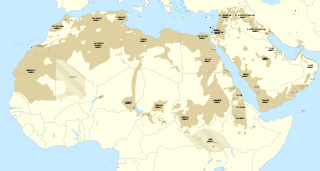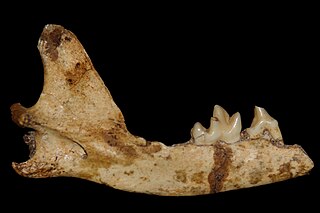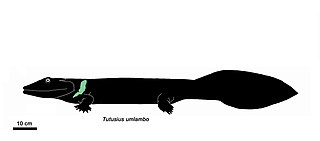
Canidae is a biological family of dog-like carnivorans, colloquially referred to as dogs, and constitutes a clade. A member of this family is also called a canid. The family includes three subfamilies: the Caninae, the extinct Borophaginae and Hesperocyoninae. The Caninae are known as canines, and include domestic dogs, wolves, coyotes, foxes, jackals and other species.

The quagga is an extinct subspecies of the plains zebra that was endemic to South Africa until it was hunted to extinction in the late 19th century. It was long thought to be a distinct species, but early genetic studies have supported it being a subspecies of plains zebra. A more recent study suggested that it was the southernmost cline or ecotype of the species.

The Semitic languages are a branch of the Afroasiatic language family. They include Arabic, Amharic, Aramaic, Hebrew, and numerous other ancient and modern languages. They are spoken by more than 330 million people across much of West Asia, North Africa, the Horn of Africa, Malta, and in large immigrant and expatriate communities in North America, Europe, and Australasia. The terminology was first used in the 1780s by members of the Göttingen school of history, who derived the name from Shem, one of the three sons of Noah in the Book of Genesis.

The lion is a large cat of the genus Panthera, native to Africa and India. It has a muscular, broad-chested body; a short, rounded head; round ears; and a hairy tuft at the end of its tail. It is sexually dimorphic; adult male lions are larger than females and have a prominent mane. It is a social species, forming groups called prides. A lion's pride consists of a few adult males, related females, and cubs. Groups of female lions usually hunt together, preying mostly on large ungulates. The lion is an apex and keystone predator; although some lions scavenge when opportunities occur and have been known to hunt humans, lions typically do not actively seek out and prey on humans.

Pelomedusidae is a family of freshwater turtles endemic to sub-Saharan Africa, including Madagascar, São Tomé, and the Seychelles. They range in size from 12 to 45 cm in carapace length, and are generally roundish in shape. They are unable to fully withdraw their heads into their shells, instead drawing them to the side and folding them beneath the upper edge of their shells, hence are called African side-necked turtles.

Ostriches are large flightless birds. They are the heaviest and largest living birds, with adult common ostriches weighing anywhere between 63.5 and 145 kilograms and laying the largest eggs of any living land animal. With the ability to run at 70 km/h (43.5 mph), they are the fastest birds on land. They are farmed worldwide, with significant industries in the Philippines and in Namibia. Ostrich leather is a lucrative commodity, and the large feathers are used as plumes for the decoration of ceremonial headgear. Ostrich eggs have been used by humans for millennia.
An unclassified language is a language whose genetic affiliation to other languages has not been established. Languages can be unclassified for a variety of reasons, mostly due to a lack of reliable data but sometimes due to the confounding influence of language contact, if different layers of its vocabulary or morphology point in different directions and it is not clear which represents the ancestral form of the language. Some poorly known extinct languages, such as Gutian and Cacán, are simply unclassifiable, and it is unlikely the situation will ever change.
Ethiopian Semitic is a family of languages spoken in Ethiopia, Eritrea, and Sudan. They form the western branch of the South Semitic languages, itself a sub-branch of Semitic, part of the Afroasiatic language family.

The conservation status of a group of organisms indicates whether the group still exists and how likely the group is to become extinct in the near future. Many factors are taken into account when assessing conservation status: not simply the number of individuals remaining, but the overall increase or decrease in the population over time, breeding success rates, and known threats. Various systems of conservation status are in use at international, multi-country, national and local levels, as well as for consumer use such as sustainable seafood advisory lists and certification. The two international systems are by the International Union for Conservation of Nature (IUCN) and The Convention on International Trade in Endangered Species of Wild Fauna and Flora (CITES).

The Late Pleistocene is an unofficial age in the international geologic timescale in chronostratigraphy, also known as the Upper Pleistocene from a stratigraphic perspective. It is intended to be the fourth division of the Pleistocene Epoch within the ongoing Quaternary Period. It is currently defined as the time between c. 129,000 and c. 11,700 years ago. The late Pleistocene equates to the proposed Tarantian Age of the geologic time scale, preceded by the officially ratified Chibanian. The beginning of the Late Pleistocene is the transition between the end of the Penultimate Glacial Period and the beginning of the Last Interglacial around 130,000 years ago. The Late Pleistocene ends with the termination of the Younger Dryas, some 11,700 years ago when the Holocene Epoch began.
James Leonard Brierley Smith was a South African ichthyologist, organic chemist, and university professor. He was the first to identify a taxidermied fish as a coelacanth, at the time thought to be long extinct.

Pachycrocuta is an extinct genus of prehistoric hyenas. The largest and most well-researched species is Pachycrocuta brevirostris, colloquially known as the giant short-faced hyena as it stood about 90–100 cm (35–39 in) at the shoulder and it is estimated to have averaged 110 kg (240 lb) in weight, approaching the size of a lioness, making it the largest known hyena. Pachycrocuta first appeared during the late Miocene. By 800,000 years ago, it became locally extinct in Europe, with it surviving in East Asia until at least 500,000 years ago, and possibly later elsewhere in Asia. There is a possibility the extant brown hyena is a member of this genus, along with the extinct Pliocrocuta and "Hyaena" prisca.

Galesauridae is an extinct family of cynodonts. Along with the family Thrinaxodontidae and the extensive clade Eucynodontia, it makes up the unranked taxon called Epicynodontia. Galesaurids first appeared in the very latest Permian period, just a million years before the greatest extinction of all time, the Permian-Triassic extinction event.

The Pleurodira are one of the two living suborders of turtles, the other being the Cryptodira. The division between these two suborders represents a very deep evolutionary divide between two very different types of turtles. The physical differences between them, although anatomical and largely internal, are nonetheless significant, and the zoogeographic implications of them are substantial. The Pleurodira are known more commonly as the side-necked turtles and the name Pleurodira quite literally translates to side neck, whereas the Cryptodira are known as hidden-necked turtles. The Pleurodira turtles are currently restricted to freshwater habitats in the Southern Hemisphere, largely to Australia, South America, and Africa. Within the Pleurodira, three living families are represented: Chelidae, also known as the Austro-South American side-necked turtles, the Pelomedusidae, also known as the African mud terrapins, and the Podocnemididae, also known as the American side-neck river turtles. However, they were cosmopolitan clade during the Cretaceous and most of the Cenozoic, and even occurred in marine environments around the world.

Gondwana was a large landmass, sometimes referred to as a supercontinent. The remnants of Gondwana make up around two-thirds of today's continental area, including South America, Africa, Antarctica, Australia, Zealandia, Arabia, and the Indian Subcontinent.

Ictidosuchoides is an extinct genus of ictidosuchid therocephalians. Fossils have been found from the Karoo Basin in South Africa. The genus is known to have been one of the few therocephalians to have survived the Permian-Triassic extinction event in this area, although its numbers were quite low after the extinction.
African village dogs are dogs found in Africa that are directly descended from an ancestral pool of indigenous dogs. African village dogs became the close companion of people in Africa, beginning in North Africa and spreading south.

Vulpes skinneri is a species of extinct fox in the genus Vulpes from the early Pleistocene, identified based on fossil remains dated to about 2 million years ago. The species is known from a single partial skeleton discovered in the Malapa Fossil Site at the Cradle of Humankind World Heritage Site in South Africa and is associated with the fossil hominin remains of Australopithecus sediba. The fossils have been dated to between 1.977 and 1.980 million years ago. Hartstone-Rose and colleagues described the remains as a newly discovered species of fox, which they named skinneri after the African mammalogist John Skinner.

Tutusius is a genus of extinct tetrapod from the Devonian of South Africa, containing a single species, Tutusius umlambo. It was described from the +/- 360 myo Gondwana locality of Waterloo Farm lagerstätte on the south-eastern coast of South Africa, which at the time was located within the Antarctic Circle. Together with the find of Umzantsia amazana from the same locality, this provides the first evidence that Devonian tetrapods were not restricted to the tropics as was formerly believed, and suggests that they may have been global in distribution. Waterloo Farm fossils have been metamorphosed and intensely flattened, with the bone tissue replaced by secondary metamorphic mica that is partially altered to kaolinite and chlorite during uplift. They also provide the first evidence of Devonian tetrapods from the continent of Africa, and only the second and third such taxa from Gondwana.
Scalenodontoides is an extinct genus of Traversodontidae, a family of herbivorous cynodonts. It lived during the Late Triassic in what is now South Africa. Its type species is Scalenodontoides macrodontes. It was named in 1957 by A. W. Crompton and F. Ellenberger. Arctotraversodon plemmyrodon was originally classified as a species of Scalenodontoides, but was given its own genus in 1992. It is found in the Scalenodontoides Assemblage Zone of the Elliot Formation, which is named for it. It is one of the geologically youngest traversodontids, alongside the putative traversodontid Boreogomphodon. It is closely related to Exaeretodon and Siriusgnathus, but is distinguished by the presence of a shelf-like expansion of its parietal called the nuchal table. Though the largest known complete skull is only 248 millimetres (9.8 in) long, it may have been the largest non-mammalian cynodont, as an incomplete snout would have belonged to a specimen with an estimated skull length of 617 millimetres (24.3 in).














